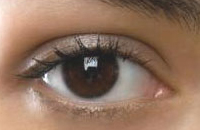
The surgery involves the elimination of the central part of the cornea, the clear front window of the eye and its replacement with a corneal graft, which is only 0.5mm thick, from a donor.
Latest femtosecond lasers enables surgeons need to use fewer sutures and can remove them more quickly after the operation.
Ultra-short pulses lasting only 50 to 1,000 femtoseconds result in finer cuts without causing much damage to the tissue.
Sheraz Daya, an eye surgeon who has pioneered the use of the technique in Britain at the Centre for Sight clinic in East Grinstead, West Sussex, said that the new technique enabled patients to recover their sight more quickly than usual.
‘Rather than trying to attach the flat surface of the eye to a flat surface, with the femtosecond laser we can precisely cut the graft to fit on the eye, forming a stronger bond. This means fewer stitches are required, and they can be taken out after just a few months. Patients can cut down on the time off work and also recover their vision quicker, as it is usually fuzzy or misty in the affected eye until the cornea settles down. Most get an acceptable degree of vision back within three months, which becomes perfect by about six months,’ said Dr. Daya.
Dr. Daya also said that the new surgery also reduces the possibilities of fragile cornea grafts being torn during the surgery.
According to Larry Benjamin, honorary secretary of the Royal College of Ophthalmologists and an eye surgeon at Stoke Mandeville Hospital, in Buckinghamshire, the new technique could also evade astigmatism, where the transplanted cornea gets distorted; leading to blurred images, and may require further surgery.
